AGRI Committee Report
If you have any questions or comments regarding the accessibility of this publication, please contact us at accessible@parl.gc.ca.
REPORT ON THE REVIEW OF THE CANADA
GRAIN ACT AND THE CANADIAN GRAIN
COMMISSION CONDUCTED BY COMPAS INC.
On 18 September 2006, Mr. David Anderson, Parliamentary Secretary to the Honourable Chuck Strahl, Minister of Agriculture and Agri-food and Minister for the Canadian Wheat Board, tabled in Parliament the independent review of the Canada Grain Act and the Canadian Grain Commission (CGC) conducted by the consulting firm Compas. In a press release announcing the tabling of the Compas report, the Minister asked the Standing Committee on Agriculture and Agri-Food “to study the review and its 102 recommendations.”
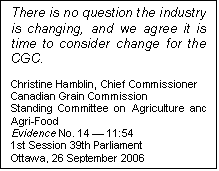 The review had to be conducted because in its fourth report in the 1st Session of the 38th Parliament the Standing Committee introduced an amendment to Bill C-40, An Act to amend the Canada Grain Act and the Canada Transportation Act. The amendment required “an independent and comprehensive review of the Commission (…) and a report of the review to be laid before each House of Parliament, including a statement of any changes recommended by the authors of the review.”1
The review had to be conducted because in its fourth report in the 1st Session of the 38th Parliament the Standing Committee introduced an amendment to Bill C-40, An Act to amend the Canada Grain Act and the Canada Transportation Act. The amendment required “an independent and comprehensive review of the Commission (…) and a report of the review to be laid before each House of Parliament, including a statement of any changes recommended by the authors of the review.”1
Although none of the witnesses fully agreed with all of Compas’ recommendations, the Standing Committee hearings revealed strong and general support for CGC reform. They also showed that the most challenging issues of the reform were common to the majority of witnesses. Therefore, the present report does not address the 102 recommendations formulated by Compas, but focuses on the common themes raised by witnesses. The issues include the following: the CGC mandate, governance, inspection activities, the government funding, liability of the CGC, kernel visual distinguishability (KVD), and research and development.
A modern, more flexible CGC is what an important grain producing country like Canada requires in an increasingly competitive global market, and a domestic market at a “crossroads” with emerging new opportunities like biofuels production in sight. The Standing Committee believes that not only is another CGC possible, but it is also essential for all stakeholders of the Canadian grain industry.
THE MANDATE OF THE CANADIAN GRAIN COMMISSION
In our estimation, the two main issues are the mandate of the Canadian Grain Commission, including whose interests it serves, and how the CGC should relate to stakeholders.2
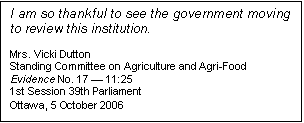 Another important issue raised during the Standing Committee’s hearings was whether or not the CGC should mainly or exclusively serve the interests of farmers. When he appeared before the Standing Committee, Dr. Conrad Winn, from Compas, stated that, in theory, in everything that the CGC has done in the past, it should have given priority to the producers. However, in practice this cannot be the case, because there are several stakeholders involved, and there are even conflicts among the producers themselves.3
Another important issue raised during the Standing Committee’s hearings was whether or not the CGC should mainly or exclusively serve the interests of farmers. When he appeared before the Standing Committee, Dr. Conrad Winn, from Compas, stated that, in theory, in everything that the CGC has done in the past, it should have given priority to the producers. However, in practice this cannot be the case, because there are several stakeholders involved, and there are even conflicts among the producers themselves.3
The proposed version of section 13 of the Canada Grain Act would remove the words “in the interest of grain producers” from the object of establishing and maintaining “standards of quality for grain and regulate grain handling in order to ensure a dependable commodity for domestic and export markets.” This amendment recognizes that the CGC exists to serve the interests of all Canadians.
Indeed, as a government agency that receives public funding, the CGC must keep in mind that it serves “the interests of all Canadians”. As legislators the members of the Standing Committee must therefore carefully consider this aspect of the CGC’s mandate.
This argument that the Commission cannot, in practice, serve only the interests of producers is bolstered by subsection 16(1) of the Act. Under this provision, the CGC may make regulations establishing grades and specifications for grain, for the “purposes of meeting the quality requirements of purchasers of grain.”4 Furthermore, the proposed amendment to section 13 adds a subsection 2 that begins with the words “in the interests of producers” for various things such as the right of delivery access and to a producer car for shipment, the right to third party grade and dockage verification, and the right of grain producers to have secure commercial transactions with various licensees.
The fact is that the CGC deals on a regular basis with various stakeholders who, sometimes, may have conflicting interests. The proposed amendment to the CGC mandate appears to establish a more balanced approach in general. Furthermore, the legal analysis conducted by the Standing Committee indicates that the proposed section 13 is more in line with the practical reality of the various activities conducted by the CGC. However, the Standing Committee recognizes that some grain producers may have concerns regarding the protection of their interests in the redefined mandate of the CGC. Therefore:
RECOMMENDATION 1
The Standing Committee supports a redefined mandate of the CGC as more in line with the practical reality of the Canadian grain industry and it recommends that any eventual bill clearly protect the interests of grain producers.
1. The Reform of the Executive Level
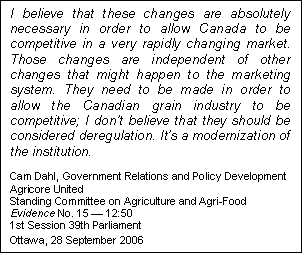 In its report, Compas states that “we do not see the formal organization of the CGC as the main cause of discontent.”5 The CGC was however created a century ago and the business environment, in the grain industry and elsewhere, has dramatically changed, and greater accountability and transparency are requirements for better regulation. Modernization of the CGC therefore requires modernization of the executive level. The Compas review suggests the creation of a single President/CEO/Chief Commissioner, supported by vice-presidents and other senior executives.
In its report, Compas states that “we do not see the formal organization of the CGC as the main cause of discontent.”5 The CGC was however created a century ago and the business environment, in the grain industry and elsewhere, has dramatically changed, and greater accountability and transparency are requirements for better regulation. Modernization of the CGC therefore requires modernization of the executive level. The Compas review suggests the creation of a single President/CEO/Chief Commissioner, supported by vice-presidents and other senior executives.
Witnesses who appeared before the Standing Committee agreed with this proposal, and at least one witness drew a parallel with other regulatory agencies such as the Canadian Food Inspection Agency (CFIA) and the Pest Management Regulatory Agency (PMRA).6 There were no discussions, however, on the details of the new proposed reform of the executive level. Should the President/CEO be appointed at pleasure or during good behaviour? What should the term be? Should the appointee be chosen from among the regular pool of deputy ministers and agency presidents of the public service, or should the person be appointed for his expertise in the grain industry rather than for his knowledge of public administration?
As legislators the members of the Standing Committee have the opportunity to review Governor in Council appointments, and recognize the highly skilled people who serve in various departments and agencies. However, because of the specificity and the complexity of the Canadian grain industry, it appears that any CEO/Chief Commissioner eventually appointed should also have a good understanding of the industry. Therefore:
RECOMMENDATION 2
The Standing Committee recommends modern governance structure for the CGC’s executive level and the appointment of a single President or CEO supported by three vice-presidents. The Committee also recommends that the CEO hold office during pleasure for a term of five years.
Furthermore, the Standing Committee recommends that, because of the intrinsic nature of the grain industry, a working knowledge of the industry should be a criterion, in addition to managerial and other skills, to be considered in the appointment process of a CEO.
2. The Six Assistant Commissioners and the Office of Grain Farmer Advocacy
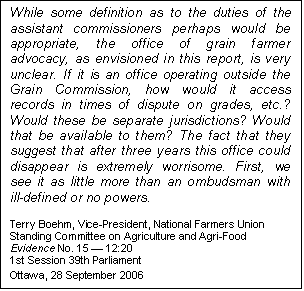 There were some discussions during the Standing Committee meetings on the role of the six assistant commissioners and whether or not their positions should be maintained. The assistant commissioners are appointed by Cabinet for a fixed term, and they are regionally located. They provide awareness in their respective regions of some of the work carried out by the CGC, and they also serve as a mechanism for complaint resolution in some cases. The Act is not very clear on their roles, which means that the way assistant commissioners perceive their role may vary from one region to another.
There were some discussions during the Standing Committee meetings on the role of the six assistant commissioners and whether or not their positions should be maintained. The assistant commissioners are appointed by Cabinet for a fixed term, and they are regionally located. They provide awareness in their respective regions of some of the work carried out by the CGC, and they also serve as a mechanism for complaint resolution in some cases. The Act is not very clear on their roles, which means that the way assistant commissioners perceive their role may vary from one region to another.
“At the best of times, they are well regarded by farmers for interceding with elevators in weighing or grading disputes but the style of their interventions are reportedly of
.
uneven quality. At the worst times, they are inhabitants of patronage heaven. The continuance of these ambiguously defined positions is in our estimation incompatible with principles of modern government.”7
In its review of the CGC and the Act, Compas recommended the establishment of an Office of Grain Farmer Advocacy, a form of an ombudsperson with the mandate to ensure that farmers understand their rights under the Act and to advocate for them in cases of disputes with other stakeholders.
Although there were few concerns expressed about the new Office, the Standing Committee regards these concerns to be very valid, particularly those regarding its powers and the possibility that it may eventually disappear following a review, conducted every three years, on the need for its services. Similar points were raised in another context by the Standing Committee in its May 2002 report on the Pest Management Regulatory Agency. The Standing Committee recommended an ombudsperson and provided details on the mandate and the relationship to the Agency. Therefore:
RECOMMENDATION 3
The Standing Committee recommends the establishment of an independent Office of Grain Farmer Advocacy composed of six commissioners deployed regionally.
Furthermore, the Standing Committee recommends that the Office be permanent and be funded to perform adequately its role of defending, in the same manner all across Western Canada, the interests of all grain producers in disputes with other stakeholders, including the CGC itself. Finally, the Office should report directly to the Minister of Agriculture and Agri-food,
The new governance structure proposed by the Standing Committee would be represented by this chart:
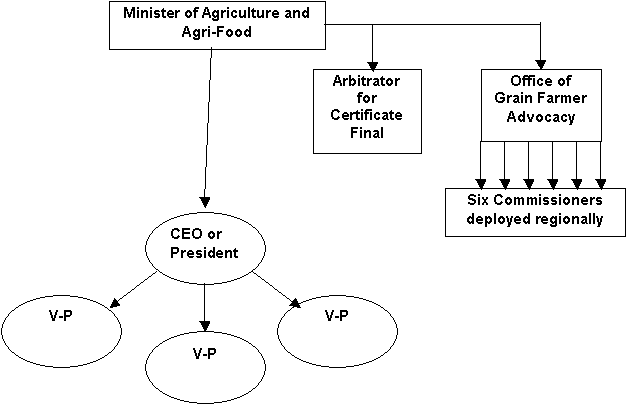
WEIGHING AND INSPECTION ACTIVITIES
“Weighing and inspection of grain is carried out by the CGC and is mandatory on bulk shipments overseas but not for container movement or for exports to the United States, where these are optional.”8 Inward inspections are the weighing and grading that take place when railcars or trucks arrive at transfer elevators or terminal elevators. The CGC then provides third-party weighing so as to forestall errors and to provide assurance to producers.
Because it is difficult to justify maintaining the current mandatory inward inspection given that it is not a universal requirement, Compas recommended that inward inspection become optional at the shipper’s request, but that outward inspection and weighing remain mandatory. In addition, Compas recommended “that the Act require the CGC to ensure that a capacity for carrying out such inward inspection be maintained at public cost.”
The Standing Committee heard differing viewpoints on both sides of the inward inspection issue, and recognizes that both carry their own merits. However, several strong factors seem to support optional inward inspection: the inward inspection requirement is already not universal; optional inspection would not affect producer rights of access to the terminal; and producers and the Canadian Wheat Board should not be unduly affected financially if a proper publicly supported infrastructure and pricing system are put into place in light of the public benefits of maintaining an inward inspection capability.9 Moreover, optional inward inspection is a perfect example of the flexibility that can be introduced, and that is required, in the current grain system. Therefore:
RECOMMENDATION 4
The Standing Committee is in favour of optional inward inspection, and recommends sufficient funding so that the CGC can maintain efficient and timely services for both producers and smaller handlers who need such services for transactional purposes.
2. Contracting Out of Inspection Services
The Review of the Canada Grain Act and the Canadian Grain Commission contains a recommendation with respect to the contracting out of services. During its review, Compas received complaints about timely inspection services in peak periods and inflexibility in service delivery, particularly regarding authorization of overtime when required.
In the Compas report and during the Standing Committee hearings the following comments were heard or reported: outsourcing would help improve the cost effectiveness of the system; for renewal contract consideration the private sector would be under pressure to provide better and more timely services; if implemented successfully, contracting out would benefit all players in the system by improving efficiencies; and, the Government of Canada Regulatory Policy allows the use of private- sector services.
However, the comments were often anecdotal and trivial, and were not supported by any strong analysis in terms of real costs and benefits. Even the section on that issue in the Compas report raises special concerns:
To ensure competitiveness, it is envisioned that more than one service provider would be engaged and sustained, which increases the complexity. The method of assigning work will need to be determined. Developing a method with multiple competitive service providers to impartially allocate the business will be critical.10
In keeping with longstanding Government of Canada Regulatory Policy, we recommend contracting out because the burden of proof and evidence should be with the proponents of the CGC service, not the proponents of contracting out. We do not believe that the proponents of CGC service have satisfied the threshold of proof. But we also do not believe that contracting out, especially in concert with inward inspection optionally, will be uneventful or a cure-all.11
At ports with multiple terminals (Vancouver, which is busiest and most congested), the process could be complex. Such complexity could increase costs and even delays.12
The Standing Committee recognizes that contracting out for inspection services will eventually bring greater efficiency and flexibility in the grain system, it however also notes that witnesses who appeared before the Standing Committee failed to provide any strong evidence that contracting out would automatically and immediately result in cost savings and improved quality services. Therefore:
RECOMMENDATION 5
The Standing Committee supports pilot projects in contracting out services for grain inspection, but recognizes the absence of strong factual data on the advantages and the costs.
In that context, the Standing Committee recommends that Agriculture and Agri-Food Canada take advantage of the first three years of the CGC reform to conduct a cost-benefit analysis on contracting out services.
RECOMMENDATION 6
In order to offer a benchmark for a cost-benefit analysis on contracting-out services, the Standing Committee recommends that the Canadian Grain Commission receive adequate funding to improve its services, particularly regarding the flexibility on authorizing overtime when specific delivery conditions are required to satisfy foreign buyers and protect Canada’s reputation.
Although Compas reported some support for optional outward inspection, it did not recommend such a change.
Canada’s reputation as a provider of superior-quality products must not be jeopardized, and mandatory outward inspection is an excellent tool for protecting Canada’s grain products at the international level. The Standing Committee therefore supports continued mandatory outward inspection and weighing.
KERNEL VISUAL DISTINGUISHABILITY (KVD)
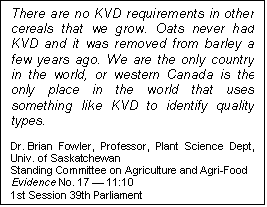 The issue of KVD was second in importance, after the one of “the interests of grain producers,” in terms of discussions during the Standing Committee hearings. It was also the issues that gave rise to the greatest number of comments contradicting the evidence presented in the Compas report. It is by far the most complex issue of the debate and the one that carries the greatest opportunities in terms of modernizing the Canadian grain industry.
The issue of KVD was second in importance, after the one of “the interests of grain producers,” in terms of discussions during the Standing Committee hearings. It was also the issues that gave rise to the greatest number of comments contradicting the evidence presented in the Compas report. It is by far the most complex issue of the debate and the one that carries the greatest opportunities in terms of modernizing the Canadian grain industry.
The system of wheat classes and grades is built on kernel visual distinguishability (KVD) and the registration system for cultivars. For wheat, cultivar registration requires assent of the Canadian Grain Commission under the authority of the Canada Grains Act while marketing of the product is a monopoly of the Canadian Wheat Board (…).
Certainly it is easy to criticize a system which must collect and segregate diverse production from across the Prairie provinces, ship and sell it halfway round the world and then accurately, fairly and usefully return value from a multitude of transactions back to those producers who contributed their grain. It is also difficult to advise those who feel they can afford not to listen. In the end all things change and so must we.
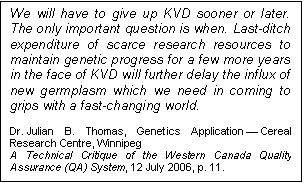 The stakes for a producer in the compromise of traits that exist in those varieties that are chosen for him are not trivial. Wheat production is not an abstraction. Wheat producers generate about 600 trillion wheat kernels per year. These are produced by real plants that consume real inputs and which are routinely assaulted by real pests and diseases. Beyond discussion the varieties which we have in place for producers are suboptimal. Otherwise, why invest in plant breeding? Nonetheless, in advancing material for registration, priority is always given to satisfying the quality assurance (QA) system as it currently exists. Multi-dimensional considerations of pest resistance, yield, and even the need for a research climate friendly to innovation are understood, but are generally secondary, or postponed or regretfully denied (…).
The stakes for a producer in the compromise of traits that exist in those varieties that are chosen for him are not trivial. Wheat production is not an abstraction. Wheat producers generate about 600 trillion wheat kernels per year. These are produced by real plants that consume real inputs and which are routinely assaulted by real pests and diseases. Beyond discussion the varieties which we have in place for producers are suboptimal. Otherwise, why invest in plant breeding? Nonetheless, in advancing material for registration, priority is always given to satisfying the quality assurance (QA) system as it currently exists. Multi-dimensional considerations of pest resistance, yield, and even the need for a research climate friendly to innovation are understood, but are generally secondary, or postponed or regretfully denied (…).
The fundamental requirement for KVD in the present QA system is to separate CWRS kernels from all others. This requires that the cultivars themselves be distinguished and that low levels of admixtures also be distinguishable. This degree of stringency requires that kernel samples of CWRS cultivars appear to be 100% uniform; as well, other types of wheat must not contain any CWRS-type kernels down to low tolerances. This requirement for absolute distinguishability places a severe burden on wheat cultivar development for reasons which are only tenuously connected with the conventional science of genetics and plant breeding.
2. The Costs Associated with KVD
The cost of maintaining KVD, both in terms of direct and indirect costs on producers and on the effects on plant breeding, was at the heart of the debate on that issue during Standing Committee hearings. Only one witness quoted a report that estimated an actual cost associated with maintaining KVD:
The cost of maintaining KVD in Western Canada we believe has been somewhat underestimated in the past and that is I guess it’s easy to underestimate the cost when you can’t see exactly what you’re missing. There have been some suggestions by a report that it’s somewhere in the neighbourhood of $200 million a year. That is arguably much higher when you consider the cumulative beneficial effects of plant breeding over time.14
That figure is derived from a non-peer-reviewed study that used the following hypotheses to establish the cost of KVD:
- Assuming that KVD is removed;
- Canadian wheat varieties would yield 5-10% more, or $3B x 5%= $150M/year;
- CWRS/CPRS and perhaps other wheat classes would include Fusarium Head Blight (FHB) resistant varieties, or between $0 to $50M/y, a mean of $25M/year;
- CWRS and several other classes would include midge resistant varieties, which could total between $10M to $50M, a mean of $30M/year; and
- The total for these three traits equal a potential cost of $200M/year.15
Another study published in 2003 (the Oleson study) used a number of scenarios to estimate a range for the impact of KVD removal. This peer-reviewed study is based on a complex methodology, but it can be summarized as follows: yield scenarios were combined with demand scenarios, and a baseline case was developed with acreage allocated so that the increase in domestic demand just met the increase in production. Revenues were therefore calculated based on realistic scenarios. The study’s conclusion is that full removal of KVD is estimated to yield an annual benefit in excess of $100 million that would be reached over the next 5 to 10 years depending on what is in the wheat breeder pipeline.16
Finally, the findings of the Oleson study were also used in another approach. Oleson estimated a loss of 5% arising from KVD constraints on plant breeding. This loss translates into a “cost” of $7 to $12 per tonne if prices range from $140 to $240 per tonne. The lost yield is applied to all production of common wheat, which includes seed, feed and downgraded production, rather than just that proportion whose identity can be preserved with advantage, as with Varietal Eligibility Declarations (VED). A scenario was then developed to estimate the accumulated difference by which CWRS trails CWAD after three decades of improvement. The yield lag was estimated at 15%, which was then multiplied by the crop size (14,000,000 tonnes as an average), multiplied by a typical price ($200 per tonne). Under this scenario these figures show that the cost of KVD could reach $420 million per year in income lost to wheat producers.17
All the reports that were brought to the attention of the Standing Committee, regardless of which scenarios or estimates were used, clearly indicated that the KVD constraint to plant breeders has a cost, which also affects wheat producers who face needed genetic enhancements delayed for years.
3. The Recent CGC Reform Regarding KVD Requirements
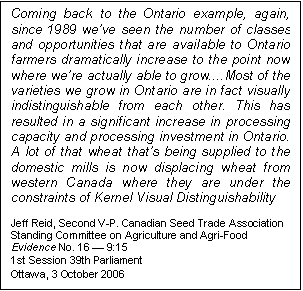 As reported in the Compas report, “the CGC announced on 29 June 2006 the establishment of a new class of wheat so as to reduce some of the barriers to innovation presented by KVD. The Canadian Grain Commission would sustain its traditional protection of quality assurance by maintaining the KVD requirements for CWRS and CWAD. The CGC would allow no new variety if it resembled visually either of these two. But, effective 1 August 2008, the CGC would end KVD requirements for minor wheat classes. The CGC would create a new class of wheat, Canada Western General Purpose (CWGP), with disease resistance and agronomic criteria but few other quality requirements and no visual requirements other than not visually resembling CWRS and CWAD.”18
As reported in the Compas report, “the CGC announced on 29 June 2006 the establishment of a new class of wheat so as to reduce some of the barriers to innovation presented by KVD. The Canadian Grain Commission would sustain its traditional protection of quality assurance by maintaining the KVD requirements for CWRS and CWAD. The CGC would allow no new variety if it resembled visually either of these two. But, effective 1 August 2008, the CGC would end KVD requirements for minor wheat classes. The CGC would create a new class of wheat, Canada Western General Purpose (CWGP), with disease resistance and agronomic criteria but few other quality requirements and no visual requirements other than not visually resembling CWRS and CWAD.”18
The literature shows that such a simplified approach to KVD is in practice not a huge leap in the direction of a more modern Canadian grain quality system. On the other hand, some stakeholders believe that the CGC’s approach is a compromise that does not put at risk Canada’s traditional export wheat varieties.
But again, if the Canadian grain industry is really at a “crossroads”, it is time to question whether the system is prepared to offer more options and greater flexibility required to meet challenges such as the biofuels strategy. Also, if Ontario wheat is indeed displacing wheat from Western Canada in the domestic milling industry, it is time to review KVD in the only place in the world that still uses it to identify quality types.
Any eventual abandonment of KVD requirements must however be accompanied by immediate control measures and, in the longer term, by support for research and development in the areas of new technologies, quality standards and market-oriented varieties. Some witnesses mentioned that the technology already available from DuPont Inc. meets the primary marketplace need to accurately analyze and grade grains.19 Therefore:
RECOMMENDATION 7
The Standing Committee recommends that kernel visual distinguishability (KVD) be abandoned, and be replaced by a system based on farmer’s declarations or affidavits supported by science-based mechanisms of quality control. The Committee also recommends that farmers’ declarations be coupled with producer and industry monetary penalties to be introduced in the Canada Grain Act.
FUNDING FOR RESEARCH AND DEVELOPMENT AND CGC INFRASTRUCTURE
1. Research and Development (R&D)
It is a well-known fact that Canada’s investment in agricultural research in general is lagging behind that of its main competitors. At these hearings, the Standing Committee heard the same message as in previous hearings: if our research budgets are not synchronized with the movement of markets at both global and domestic levels, Canada will sooner or later lose some of its comparative advantages in agriculture. Innovation is not a static concept, and increased investments in research and development (R&D) must not be driven only by sudden crises such as the avian flu or BSE.
What is true for agriculture in general is particularly true for the grain industry. With opportunities like biofuels on the horizon, a “new” grain industry must develop a R&D strategy that will allow it to face new challenges and to blossom.
Compas recommended that the federal government embark on a long-term (7-10 year) plan to greatly increase, by fourfold in 10 years, or $40 million, grain research spending with the largest portions targeted towards the Grain Research Laboratory (GRL). Matching initiatives, a centre of excellence, an outsourcing research program, and separate appropriation funding for the GRL, are among the various detailed recommendations formulated by Compas.
Many factors justify a well-integrated and planned R&D strategy for grain. They include the following: increasing grain demand and production from emerging countries; an eventual reform of the QA system; rapid changes in world market conditions; modifications in the grain production pattern as a result of climate change; and, biofuels or other non-food uses for grain. Therefore:
RECOMMENDATION 8
The Standing Committee supports the proposed increase, to about $40 million, for R&D funding in the grain industry, and also supports a separate appropriation for the Grain Research Laboratory (GRL). Furthermore, the Standing Committee recommends that the government conduct a study to determine if the GRL would be better located, and become more independent, under Agriculture and Agri-Food rather than under the Canadian Grain Commission.
The previous recommendation also raises the issue of the general funding provided to the CGC. Compas concluded that “there are several reasons for believing that the CGC is funded inadequately.”20 That raises the following question: how should it be funded? How much should the benefiting stakeholders contribute? What should the contribution of taxpayers be?
What are the CGC infrastructure costs? Compas has defined infrastructure broadly “to include both physical infrastructure and the ongoing management capability necessary to provide incremental individual services necessary for commercial transaction.” Because the grain economy has enormous economic importance as Canada’s third largest export sector and significant potential importance for both the environment and security of supply in respect of energy, Compas concluded that “the people of Canada and hence the federal government have a special reason to protect and sustain the regulatory system and infrastructure.” Compas recommended “that the federal government defray all basis infrastructure costs of the CGC, assigning cost recovery to the marginal expenses associated with individual services necessary for commercial transaction.”21
It is unclear that the reasons referred to by Compas for its recommendation provide a solid rationale for its recommendation. The fact is that many other sectors of the Canadian economy can also claim that they “have enormous economic importance”, and that they are important exporters and “have significant importance for both the environment and security of supply in respect of energy.” This raises some concerns for legislators because infrastructure should also be considered a public good as well. A real public good is a good that is non-rival; in other words, consumption of the good by one individual does not reduce consumption by other individuals. The use of public roads is an example. A real public good is also non-excludable, which means that is almost impossible, or only at a very large cost, to exclude one individual from using the road. It is unclear how this applies to the grain industry.
Some witnesses who appeared before the Standing Committee recognized that the Compas recommendation may put a lot of pressure on government expenditures. Because timely delivery is directly related to the issue of competitiveness, the Standing Committee has already recommended that overtime costs be covered by the government, but for the moment it is unclear what other CGC infrastructure costs should be defrayed by the government. Therefore:
RECOMMENDATION 9
The Standing Committee recommends that the government review all the CGC infrastructure costs, including costs related to overtime and other individual services necessary for commercial transaction, and establish which ones may deserve to be defrayed by the taxpayers of Canada, so as to ensure the long-term sustainability of these services.
LIABILITY AND CERTIFICATE FINAL
In general, the Standing Committee hearings show that stakeholders wish to see increased and better defined liability in the entire grain system. The Standing Committee agrees that reform of the CGC will not be possible without a clear accountability level for all stakeholders and regulators of the grain handling, marketing and transportation system.
The issue of Certificate Final was used as an example of the required liability in the system. A Certificate Final is issued by the CGC when ships are loaded at port, but errors are always possible. If a Certificate Final is not “final”, there is a cost associated with the change of standards. In a regulatory system such as CGC operations, the question is: what level of liability should the CGC carry? Changes to the Certificate Final do not occur very often; the last such event took place on 23 September 2004, but the possibility is there and therefore must be included in the review of the Act and regulations.
Some witnesses also mentioned that CGC grading standards are not always constant, and changes have a detrimental monetary impact on producers and grain handlers. In such a situation whoever is responsible should pay for damages.
In the case of the integrity of a Certificate Final, Compas recommended an amendment to the Canada Grain Act “to hold the CGC and the federal government as its underwriter, responsible for up to 33% of harm incurred.” Compas also suggested that an arbitrator appointed by the Minister of Agriculture and Agri-Food determine the value of the harm.22
Although it is understood that a limited responsibility for the CGC will force all other stakeholders to also be responsible, the Standing Committee hearings did not permit the Committee to clarify why the limit of responsibility would be 33% or if it was an optimal
limit. In a previous recommendation, the Standing Committee already recognized that farmers had to be liable under the Canada Grain Act, as should other stakeholders. Therefore:
RECOMMENDATION 10
The Standing Committee supports the concept of an independent arbitrator (appointed by the Minister of Agriculture and Agri-Food), and recommends that the government consider amalgamating the functions of the arbitrator in the Office of Grain Farmer Advocacy. Further, the Standing Committee recommends that the government re-evaluate the level of responsibility a reformed CGC should carry in the future. (see chart in recommendation 3)
In their discussions with members of the Standing Committee, some witnesses raised the issue of the contractual security required in the system. The question is what kind of protection should be offered to farmers and other sellers in the event of another stockholder’s failure to pay? Compas reports that, “since 1982, there have been 19 failures of licensed, bonded, companies. Of these 19, there are 3 instances where the payout was less than 100%, 1 being virtually 100% (98.4%). There are 2 other instances where the CGC paid producers 100% for failures of companies that were not licensed or carrying security. The CGC made payments in addition to or in the absence of security provisions in a total of 5 cases.”23
Although the CGC requires licensees to post security in the form of bonds, cash deposits, letters of credit, and other types of guarantees, the entrance of new players and subsectors in the system has apparently led to uneven compliance. According to some witnesses the lack of uniformity has been detrimental to smaller players. Some companies associated with smaller operations, particularly those in the special crop sector, have complained that existing CGC security requirements are too onerous and inflexible. It is argued that posting of bonds to cover 100% of the liability limits operating capital and acts as a barrier for new companies and restricts competition.
Based on a submission from the Western Barley Growers Association and suggestions from other groups, Compas recommended that the CGC “explore the costs and benefits of operating a clearinghouse mechanism.”24 Compas also recommended a stakeholder round table based on the Canadian Food Inspection Agency model, which could develop solutions to provide optimal security and fair prices for producers.
Similarly, a witness who appeared before the Standing Committee suggested an approach similar to the Ontario’s Grain Financial Protection Program (GFPP), which is a system of fees similar to a check-off that protects producers from failure of payment by licensed grain handlers. The GFPP is administered by Agricorp on behalf of the Ontario Ministry of Agriculture, Food and Rural Affairs. Another witness suggested that the provision of bonding should become a voluntary service because that would remove the barrier to entry within the industry. Producers would then have the freedom to select a bonded or non-bonded facility depending of the level of risk aversion each farmer has.
The Standing Committee recognizes that modernization of the grain system must be accompanied by an efficient and flexible system of contractual security that will be understood by all participants. Being at the beginning of the system chain, grain producers require protection against potential failures emerging from downstream activities in the grain sector. Therefore:
RECOMMENDATION 11
The Standing Committee recognizes the necessity of contractual security and supports the concept of a clearinghouse, or other models such as the Ontario’s Grain Financial Protection Program. However, the Standing Committee believes that such an important risk management tool requires further investigation and therefore recommends that the federal government report back to the Standing Committee, prior to the tabling of a new grain legislation, on the various models that could be implemented for protecting grain farmers.
The allocation of producer cars by the CGC is an issue that neither the Compas report nor witnesses mentioned. Under the Canada Grain Act grain farmers have the right to order producer cars. It is the CGC’s responsibility to provide a service to producers by arranging for the transportation of their grain.
Under the Canada Grain Act, elevators and grain dealers must be licensed by the CGC and post security to cover their liabilities to grain producers. The CGC exempts producer car loading facilities from these provisions, as long as they meet certain conditions. Therefore, grain handled and stored at producer car loading facilities is not protected by security held by the CGC.
The CGC allocates rail cars available from the railways for both CWB and non-CWB grains. For CWB grains, the CGC allocates cars based on the CWB grain and grade program. The producer must have a valid CWB delivery permit book and ensure that sufficient acreage-based or contract delivery calls are in place. For non-CWB grains, the CGC allocates cars depending on whether the producer has a confirmed sale or not. If a sale has not been confirmed, the number of allocated cars is limited to 10% of the cars for shipment of any one type of grain to a particular destination. In all cases, CWB grain or non-CWB grain, the CGC allocates cars in each category to producers in the order the applications are received.25
Because of the importance of producer cars for grain farmers, the Standing Committee believes that a CGC reform must also allow an enhancement of the producer cars allocation system. Therefore:
RECOMMENDATION 12
The Standing Committee recommends that the Canadian Grain Commission facilitate and maintain access to producer cars, and that CGC’s inward inspection on producer cars be maintained.
Members of the Standing Committee have carefully listened and discussed with witnesses, and they believe that these recommendations will be helpful in developing a new grain regulatory system that will take into consideration the interest of grain producers and that of all stakeholders. Members are looking forward for a new legislation that the Standing Committee will review carefully whenever it will be referred to it.
| 1 | Standing Committee on Agriculture and Agri-food Web site, /Error/Error.asp"20pt" valign="top" class="FNote">2 | Compas, Review of the Canada Grain Act and the Canadian Grain Commission, 15 August 2006, p. 31. |
| 3 | Standing Committee on Agriculture and Agri-Food, Evidence, no 15 — 11:50, 1st Session 39th Parliament, Ottawa, 28 September 2006. |
| 4 | Emphasis added. |
| 5 | Compas, p. 39. |
| 6 | Agricore United, Response to the Review of the Canada Grain act and the Canadian Grain Commission — A Submission to the House of Commons Standing Committee on Agriculture and Agri-Food, 28 September 2006, Ottawa, p. 4. |
| 7 | Compas, p. 40. |
| 8 | Ibid., p. 54. |
| 9 | Ibid., pp. 56-57. |
| 10 | Ibid., p. 60. |
| 11 | Ibid., p. 61 |
| 12 | Ibid., p. 61. |
| 13 | The entire background section includes large excerpts from a report entitled, A Technical Critique of the Western Canada Quality Assurance (QA) System, written by Dr. Julian B. Thomas, from Genetics Applications — Cereal Research Centre, 12 July 2006. The report was provided to the Standing Committee for its consideration. The drafter of the Standing Committee has edited Dr. Julian’s text to fit in the present report, but respected the letter and spirit of the text. |
| 14 | Standing Committee on Agriculture and Agri-Food, Evidence, no. 16 — 9:15, 1st Session, 39th Parliament, Ottawa, 3 October 2006. |
| 15 | Jim Bole, Research Advisor, FarmPure Seeds, KVD as an Impediment to Wheat Development, no date of publication (see Appendices for a copy of the study). |
| 16 | Brian T. Oleson, Kernel Visual Distinguishability (KVD) Identifying the Benefits of Moving Away from KVD, prepared for the Canadian Grain Commission, August 2003. |
| 17 | Dr. Julian B. Thomas, p. 14 (see Appendices for a copy of the study). |
| 18 | Compas, p. 47. |
| 19 | Standing Committee on Agriculture and Agri-Food, Evidence, no. 17 — 11:35, 1st Session, 39th Parliament, Ottawa, 5 October 2006. |
| 20 | Compas, p. 43. |
| 21 | Ibid. |
| 22 | Ibid., p. 63. |
| 23 | Ibid., p. 68. |
| 24 | Ibid., p. 69. |
| 25 | Source: Canadian Grain Commission Web site. |